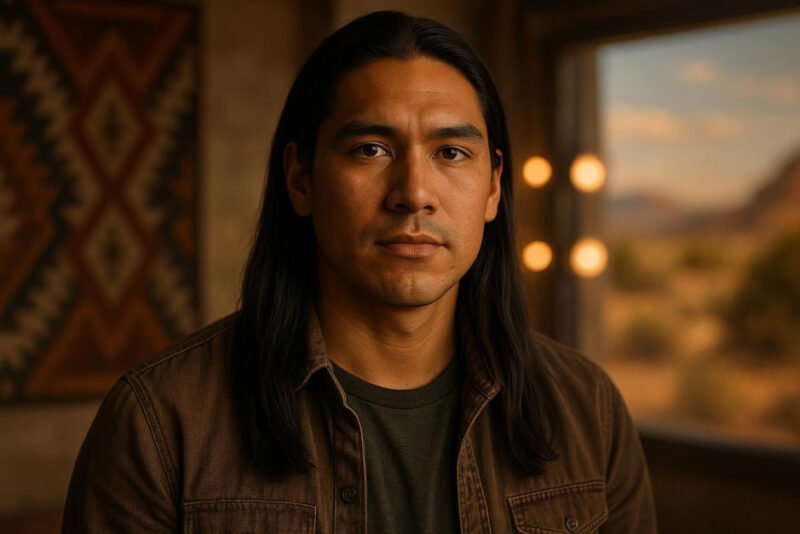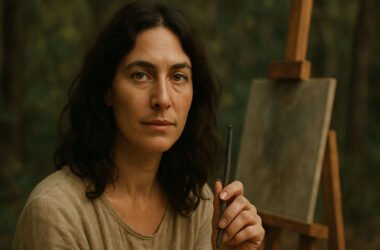Early Life and Cherokee Heritage
Kholan Garret Studi entered the world on September 29, 1993, in Santa Fe, New Mexico, a city known for its rich artistic community and cultural diversity. Growing up in this environment provided him with early exposure to various forms of creative expression, from traditional Native American arts to contemporary performance.
His Cherokee Nation citizenship forms the cornerstone of his identity, connecting him to centuries of storytelling traditions and cultural practices. This heritage isn’t merely a background detail in his biography; it actively shapes his approach to acting and his choice of projects.
The mixed heritage that includes Irish, Scottish, and Ukrainian ancestry reflects the complex reality of many modern Native American families. Rather than diluting his Cherokee identity, this multicultural background has enriched his understanding of different perspectives and experiences.
Growing up in Santa Fe meant being surrounded by a community that values artistic expression and cultural preservation. The city’s unique blend of Native American, Hispanic, and Anglo influences created an environment where young Kholan could appreciate the importance of authentic representation in storytelling.
Following in Famous Footsteps
The name Studi carries significant weight in Hollywood, particularly within Native American cinema. Wes Studi, Kholan’s father, has established himself as one of the most recognizable and respected Cherokee actors in the industry, known for powerful performances in films like “Dances with Wolves” and “The Last of the Mohicans.”
However, being the son of a famous actor presents both opportunities and challenges. While doors may open more easily, the pressure to prove oneself independently can be overwhelming. Kholan has navigated this reality with grace, acknowledging his father’s influence while working to establish his own artistic identity.
His mother, Maura Dhu Studi, also brings acting experience to the family dynamic. This means Kholan grew up in a household where the craft of acting was discussed, analyzed, and practiced regularly. The dinner table conversations likely included discussions about character development, script analysis, and the business side of entertainment.
The family’s artistic legacy extends even further back through his maternal grandfather, Jack Albertson, a respected actor known for his work in both film and television. This multi-generational connection to entertainment has provided Kholan with unique insights into the industry’s evolution and the importance of longevity in an actor’s career.
Professional Acting Debut
Kholan’s entry into professional acting came remarkably early, at just fourteen years old. His first role in “Among The Shadows Haunting” placed him alongside established Native American actors Gary Farmer and DeLanna Studi, providing invaluable learning experiences from industry veterans.
This early start wasn’t simply a case of nepotism opening doors. The young actor had to prove himself capable of handling the responsibilities that come with professional work, including memorizing lines, taking direction, and maintaining focus during long shooting days.
Working with Gary Farmer, a respected figure in Indigenous cinema, exposed Kholan to different acting techniques and approaches to character development. These early mentorships helped shape his understanding of how to bring authenticity to Native American characters without falling into stereotypical portrayals.
The experience of working on a professional set at such a young age taught him valuable lessons about the collaborative nature of filmmaking. He learned to work with directors, cinematographers, and fellow actors, understanding that great performances emerge from teamwork rather than individual effort alone.
Building a Diverse Portfolio
As Kholan matured as an actor, his filmography began to reflect a deliberate choice to explore various genres and character types. His role as Slayer Hoard 7 in “The Hunted” (2015) demonstrated his ability to handle action-oriented material, while his work in “Ray Gun” (2017) showcased his range in different storytelling contexts.
The diversity in his project choices reflects a strategic approach to career development. Rather than being typecast in specifically Native American roles, he has sought opportunities that allow him to demonstrate his versatility as a performer.
His appearance in “Tulsa King” (2024) marked a significant milestone, placing him in a high-profile television series alongside established stars. Playing the character Millo, he brought his unique perspective to a contemporary crime drama, proving that Native American actors can excel in mainstream entertainment.
Each project has contributed to his growth as an actor, teaching him new skills and exposing him to different working methods. From independent films to major television productions, he has gained experience across various scales of production, understanding the unique demands each presents.
Theater and Live Performance
While film and television work forms a significant part of his career, Kholan has also embraced the challenges and rewards of live theater. His involvement with “Between Two Knees” by The 1491s represents his commitment to Native American storytelling in its most immediate form.
Working as an understudy in this production required him to master multiple roles, including Isaiah, Eddie, Pale Face, and William. This experience demanded exceptional preparation and adaptability, as he needed to be ready to step into any of these characters at a moment’s notice.
The production’s run at prestigious venues including Seattle Rep, Yale Repertory Theatre, and the Kennedy Center exposed him to diverse audiences and different theatrical traditions. Each venue brought its own energy and expectations, requiring him to adjust his performance accordingly.
Live theater offers something that film and television cannot: the immediate connection between performer and audience. This direct feedback loop has helped Kholan develop his instincts as a performer, learning to read audience reactions and adjust his energy in real-time.
Cultural Advocacy and Representation
Beyond his individual career achievements, Kholan Studi represents something larger: the continuation of authentic Native American representation in entertainment. His work carries the responsibility of ensuring that Cherokee and broader Indigenous stories are told with respect and accuracy.
This responsibility extends beyond simply accepting roles written for Native American characters. He actively seeks projects that challenge stereotypes and present Indigenous people as complex, contemporary individuals rather than historical figures frozen in time.
His approach to advocacy differs from traditional activism, working instead through the power of authentic representation. By bringing genuine Cherokee perspective to his roles, he helps audiences understand the modern reality of Native American life.
The impact of this representation extends beyond entertainment value. Young Native American viewers see themselves reflected in contemporary media, understanding that their stories and experiences have value in the broader cultural conversation.
Future Prospects and Ongoing Projects
As Kholan Studi continues to develop his career, the trajectory suggests an actor committed to meaningful work rather than simply commercial success. His recent projects indicate a careful selection process, choosing roles that align with his values and artistic goals.
The entertainment industry’s growing recognition of the importance of authentic representation creates new opportunities for actors like Kholan. Streaming platforms and production companies increasingly seek genuine voices to tell diverse stories, positioning him well for future success.
His commitment to both his craft and his cultural heritage suggests a career that will continue to bridge traditional Cherokee values with contemporary storytelling needs. This balance positions him as a valuable voice in an industry still learning how to respectfully incorporate Indigenous perspectives.
The foundation he has built through diverse experiences in film, television, and theater provides him with the skills necessary to tackle increasingly complex and challenging roles. As he continues to mature as an actor, audiences can expect to see him take on more prominent and demanding parts that showcase his full range of abilities.









